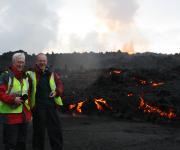College Fellow’s Explosive Exhibit at the Royal Society
2016-10-12
Prof Bob White, Fellow, Member of the Faraday Institute, and his seismology group had one of the exhibits at the Royal Society Summer Science Exhibition. The occasion showcases some of the best of British scientific research and Bob White’s group contribution revolved around the 2014 Holuhraun eruption in Iceland that they are studying.
For a week in early July the halls of The Royal Society in London resounded to the thuds of 2,000 people as they jumped as high and as hard as possible. Amongst them were children, their parents, Professors, Fellows of the Royal Society and at least one Ambassador. They were trying to get to the top of the Royal Society’s ‘Make a Quake’ leader board. The average jump was equivalent to a magnitude -0.3 earthquake. That’s 100 million million times less energy than the 2011 Tohoku earthquake in Japan that generated a Tsunami that flooded the Fukushima nuclear power plant.
The week in London was the culmination of 5 months of preparation by a group of 27 folk who helped to build and man the exhibit in rotation. Some 15,000 people passed through the exhibition. Even more popular than ‘make a quake’ was an arcade-style reaction-time game showing how earthquakes are located: by pressing buttons to record the time that waves from a randomly generated earthquake passed by each virtual seismometer, the location could be calculated and compared to the actual position using similar software to that used on real earthquakes.

Other exhibits included ash and lava to get your hands on, and a volcanic eruption model. Here the group revealed why the Holuhraun eruption didn’t stop a single flight despite being the largest Icelandic eruption in 250 years and ten times bigger than the Eyjafjallajökull eruption which grounded over 100,000 flights in 2010.
There you will also find a set of simple experiments you can do at home, each with a video display of its own: great to show children and grandchildren, but often done for the secret enjoyment of the adults. Profe White admits: ‘My favourite is blowing the top off a film canister by dropping an Alka-Seltzer into a few thimblefuls of water. Just last week I stood 3000 foot up on the crater rim of Stromboli at dusk watching tons of red-hot rock being blasted into the air every few minutes by essentially the same mechanism of gas release. It reminds me why I love geology.’

